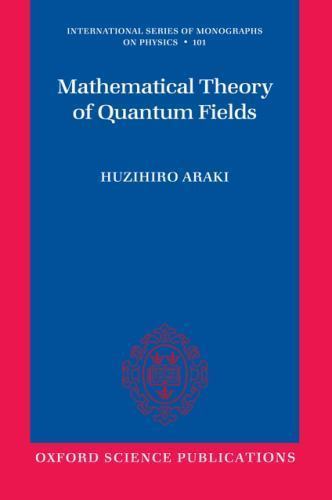Imagen 1 de 1

Foto genérica

Imagen 1 de 1

Foto genérica

International Series of Monographs on Physics Ser.: Mathematical Theory of Quantum Fields by Huzihiro Araki (2009, Trade Paperback)

grandeagleretail (959892)
98,7% de votos positivos
Precio:
USD92,86
Aproximadamente79,98 EUR
+ USD13,52 de envío
Devoluciones:
Estado:
Mathematical Theory of Quantum Fields by Huzihiro Araki, Ursula Carow-Watamura. Author Huzihiro Araki, Ursula Carow-Watamura. The basic key physical notions are clarified at this point. This is an authoritative and self- contained introduction to the subject, which uses the mathematical theory of operator algebras to present the theory.
Oops! Looks like we're having trouble connecting to our server.
Refresh your browser window to try again.
Acerca de este artículo
Product Identifiers
PublisherOxford University Press, Incorporated
ISBN-100199566402
ISBN-139780199566402
eBay Product ID (ePID)72097347
Product Key Features
Number of Pages256 Pages
LanguageEnglish
Publication NameMathematical Theory of Quantum Fields
SubjectPhysics / Quantum Theory, General
Publication Year2009
TypeTextbook
Subject AreaMathematics, Science
AuthorHuzihiro Araki
SeriesInternational Series of Monographs on Physics Ser.
FormatTrade Paperback
Dimensions
Item Height0.6 in
Item Weight12.9 Oz
Item Length9.2 in
Item Width6.1 in
Additional Product Features
Intended AudienceScholarly & Professional
Dewey Edition22
Reviews"The self-contained monograph provides an introduction to the basic properties of quantum fields suitable for mathematics graduates." --Aslib, 'The self-contained monograph provides an introduction to the basic properties of quantum fields suitable for mathematics graduates. 'Aslib
Series Volume Number101
Dewey Decimal530.143
Table Of ContentStates and observablesQuantum theoryThe relativistic symmetryLocal observablesScattering theorySector theoryAppendix A: Hilbert space and operatorsAppendix B: Operator algebrasAppendix C: Free fields
SynopsisQuantum field theory is an area of wide and growing interest to students and researchers of both mathematics and physics. This is an authoritative and self- contained introduction to the subject, which uses the mathematical theory of operator algebras to present the theory., This is an introduction to the mathematical foundations of quantum field theory, using operator algebraic methods and emphasizing the link between the mathematical formulations and related physical concepts. It starts with a general probabilistic description of physics, which encompasses both classical and quantum physics. The basic key physical notions are clarified at this point. It then introduces operator algebraic methods for quantum theory, and goes on to discuss the theory of special relativity, scattering theory, and sector theory in this context.
LC Classification NumberQC174.45








